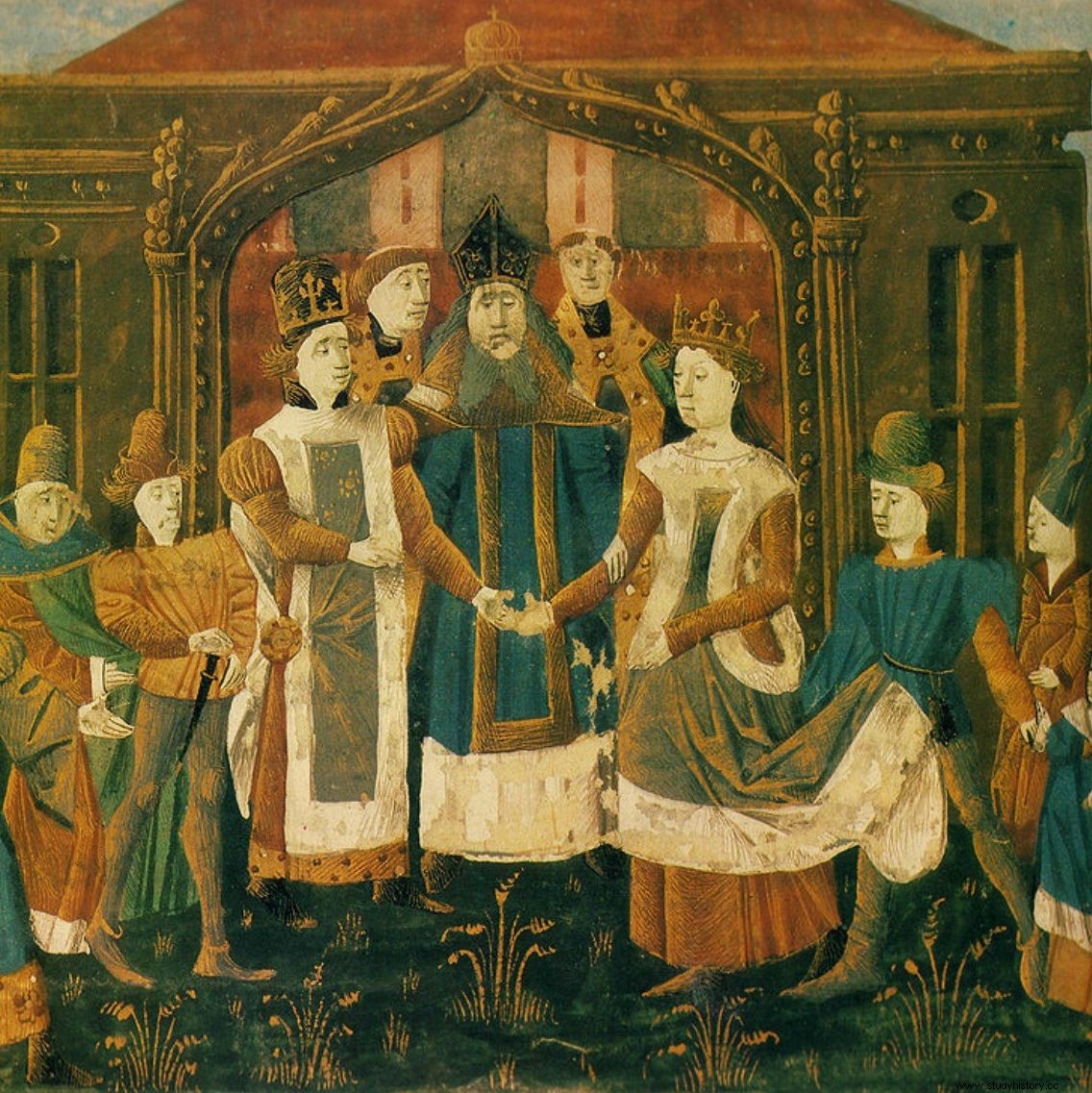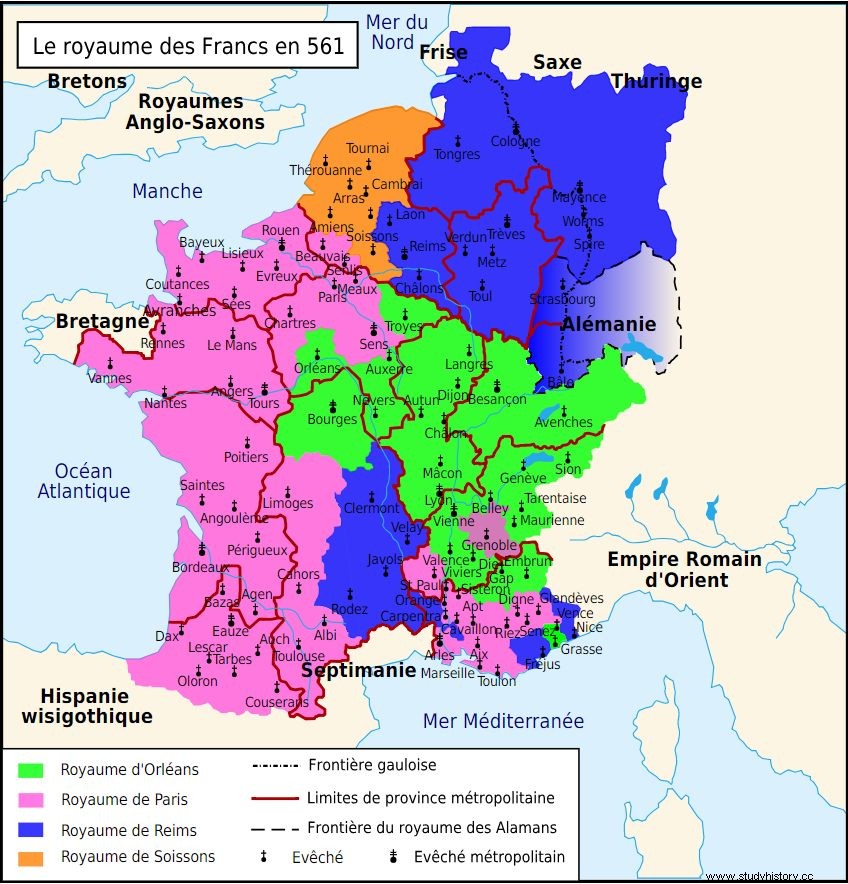Visigoth princess then queen of the Franks, Brunehaut (circa 547 – 613) reigned for 33 years. She is known in particular for her conflicted relationship with the queen of Neustria of her time, Fredegonda .
From Visigoth princess to queen of the Franks

Born around 547, at the beginning of the Middle Ages, Brunehaut (or Brunehilde) was the daughter of the Visigoth king of Hispania and Septimania (province of Narbonne) Athanagilde I st , king of the Germanic people of the Visigoths, and his wife Queen Goswinthe. She was raised in the Arian faith, a theological current of early Christianity.
A faith that the princess will have to abjure to get married. In 566, when she was about nineteen years old, Brunehaut married Sigebert I st , King of Metz since the death of his father five years earlier. On the death of King Clotaire I st in 561, the kingdom of the Franks was indeed divided between his four sons.

The eldest, Caribert, receives the kingdom of Paris. Chilpéric receives the kingdom of Soissons, Gontran the former kingdom of Burgundy (which will be known as the kingdom of Burgundy). Finally, the husband of Brunehaut, Sigebert, inherited the kingdom of Reims. A few years later, Calibert died without a male heir. His lands are again divided between his brothers, redrawing the borders of the Merovingian kingdoms (Austrasia, Neustria and Burgundy), and opening the way to new tensions.
Galswinthe's wedding
From the marriage of Brunehaut and Sigebert will be born three children:the princesses Ingonde and Clodoswinthe, and the prince Childebert who will become Childebert II. This alliance through the marriage of Austrasia and Visigothic Hispania worried Sigebert's brother, Chilpéric; the following year, he forged his own alliance by marrying Brunehaut's big sister, Galswinthe.
In 567, Athanagilde I st , the father of Brunehaut and Galswinthe dies, reshuffling the cards of political alliances. In the eyes of Chilpéric, her union with Galswinthe loses all interest, beyond the dowry she brought him. In order not to lose this dowry, he does not repudiate her but has her murdered before remarrying a few days later with a concubine, Frédégonde. A murder that will be the starting point of a long conflict between Austrasia and Neustria.
The royal faide
Determined to obtain compensation for the murder of her sister, Brunehaut has her husband file a complaint. A court, of which his brother-in-law Gontran is the judge, is set up and cedes to Brunehaut the dower – the property of the husband reserved for the wife in the event of death – of Galswinthe, namely cities of Aquitaine . But Chilperic refuses to submit, and the tensions born during the division of the kingdoms are exacerbated. This is the starting point of the royal faide (a traditional revenge), a war between Austrasia and Neustria.
In 575, the conflict turns to the advantage of Sigebert, to the point that he is recognized as king of Neustria by the troops of Chilpéric, but he is assassinated in December on the orders of his enemies. This murder allows Chilpéric to turn around a military situation that was turning against him, and to take Paris. Warned of her husband's death, Brunehaut only has time to put her son Childebert, his father's heir, to safety before being taken prisoner.
While Childebert, who was then only five, was taken to Metz, proclaimed king by his supporters and placed under the protection of Gontran, Brunehaut was sent to Rouen. There she meets Mérovée, son of Chilpéric and from his first marriage to Queen Audovère. The two married in 576, provoking the wrath of Chilpéric and Frédégonde. In retaliation, Merovée's father had his son tonsured; Mérovée will be assassinated the following year. Widowed again, Brunehaut escapes the custody of Chilpéric.
Ruler of Austrasia and Burgundy
As she joined her son in Metz and tried to regain her place at his side, Brunehaut initially came up against the opposition of several great figures of the kingdom, who only recognized the power of Childebert II. . In 584, Chilpéric I st is assassinated by a killer who disappears without a trace – chroniclers accuse Brunehaut, others Frédégonde -, and leaves behind a widow and an heir of four months, Clotaire.
Frédégonde and Brunehaut both seek to get closer to their brother-in-law, Gontran. Frédégonde has her son adopted by the King of Burgundy to protect him, but she gets rid of his influence and their relationship becomes conflictual. Brunehaut and his son signed the Treaty of Andelot with Gontran in 587, making the two kings the heir of the other in the event of their death. Five years later, on the death of Gontran, Childebert II thus inherited the kingdom of Burgundy. Brunehaut becomes the de facto ruler of Austrasia and Burgundy. A role that sees her once again confront the queen of Neustria Fredegonda, in open conflict with her kingdoms on behalf of her young son.
In 595, Brunehaut conceives and writes the decree of Childebert, an important text which profoundly modifies the institutions of the kingdom, in particular justice, and modifies the Salic law. She made faide a matter of royal justice to put an end to private revenge, established the right of women not to be married against their will - as her sister was -, established a principle of equality between Franks and Gallo-Romans, reinforces the central power.
Regent of Austrasia
In 596, Childebert died poisoned with his wife. His two sons, Thibert and Thierry, aged eleven and nine respectively, share the kingdom, breaking the alliance of Austrasia and Burgundy. Thibert receives Austrasia and Thierry Burgundy, while Brunehaut is made regent and settles with Thibert in Metz.
While repelling the assaults of Neustria, which took advantage of the death of Childebert to launch offensives, Brunehaut tried to consolidate his power. She always comes up against the opposition of certain greats of the kingdom, who refuse the authority of a woman. The Duke of Champagne Wintrio, in particular, conspired against Brunehaut after declaring himself in his favour. In retaliation, the regent had him assassinated in 598, a murder which earned him the wrath of the nobles of Austrasia. Driven out by Thibert, she took refuge in 601 with her other grandson, Thierry II.
Regent of Burgundy
At the court of the young king of Burgundy, Brunehaut placed his favorite supporter, Protade, as mayor of the palace. He will be assassinated two years later by the greats of the kingdom. Quickly, a conflict broke out between Thierry and Thibert around the sharing of land and in particular Alsace, attributed to Thierry. During the conflict, Thibert is killed, and Thierry becomes king of Austrasia. A very brief reign, since he died in Metz the following year, leaving four sons.
Instead of dividing the kingdom between the four children, Brunehaut places on the throne only one of his great-grandsons, Sigebert II, who is then only twelve years old. But the regent still lacked support among the nobility of Austrasia; some of them revolted, going so far as to take the side of the king of Neustria, Clotaire II, the son of Frédégonde. Deprived of support, Brunehaut fled but was arrested in 613 and delivered to Clotaire. Sigebert II and his brothers are also arrested.
The King of Neustria had Sigebert II and his brother Corbus executed, while their brother Mérovée was sent into exile. He then had Brunhild tortured for three days by the men of his army, before having her publicly executed in a particularly brutal way, by attaching her to the tail of a wild horse. His body is then burned. She will be buried at the Saint-Martin d'Autun abbey which she had founded herself.
